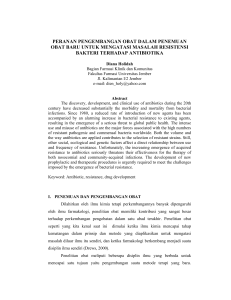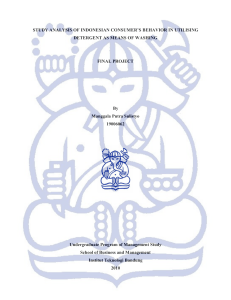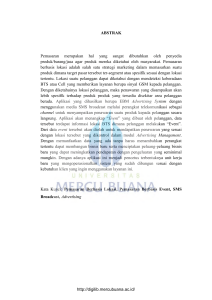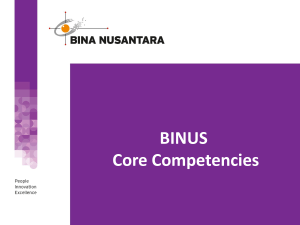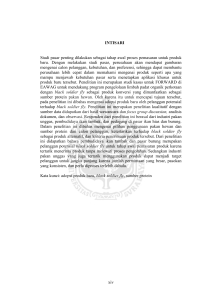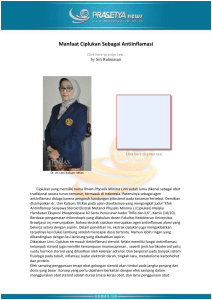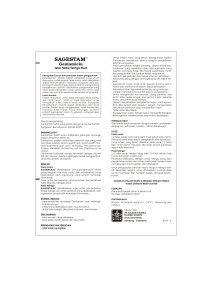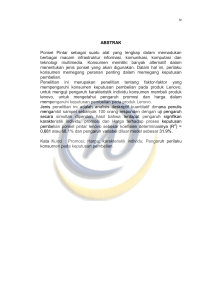iii MODEL ANALISIS PENGEMBANGAN PRODUK - Repository
advertisement
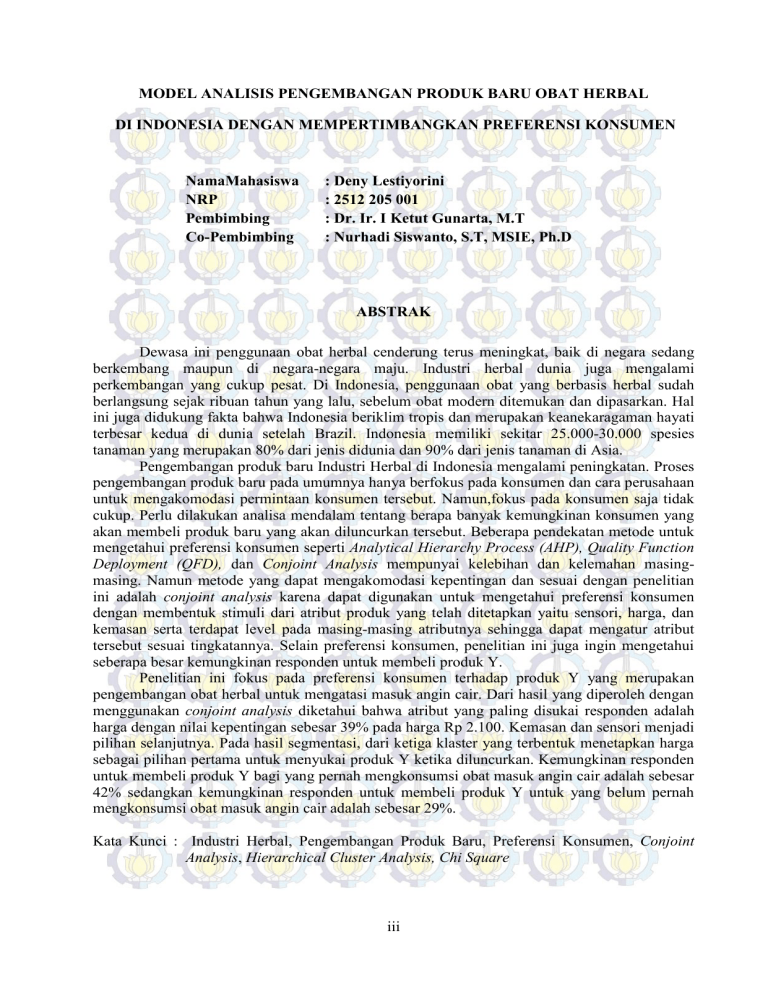
MODEL ANALISIS PENGEMBANGAN PRODUK BARU OBAT HERBAL DI INDONESIA DENGAN MEMPERTIMBANGKAN PREFERENSI KONSUMEN NamaMahasiswa NRP Pembimbing Co-Pembimbing : Deny Lestiyorini : 2512 205 001 : Dr. Ir. I Ketut Gunarta, M.T : Nurhadi Siswanto, S.T, MSIE, Ph.D ABSTRAK Dewasa ini penggunaan obat herbal cenderung terus meningkat, baik di negara sedang berkembang maupun di negara-negara maju. Industri herbal dunia juga mengalami perkembangan yang cukup pesat. Di Indonesia, penggunaan obat yang berbasis herbal sudah berlangsung sejak ribuan tahun yang lalu, sebelum obat modern ditemukan dan dipasarkan. Hal ini juga didukung fakta bahwa Indonesia beriklim tropis dan merupakan keanekaragaman hayati terbesar kedua di dunia setelah Brazil. Indonesia memiliki sekitar 25.000-30.000 spesies tanaman yang merupakan 80% dari jenis didunia dan 90% dari jenis tanaman di Asia. Pengembangan produk baru Industri Herbal di Indonesia mengalami peningkatan. Proses pengembangan produk baru pada umumnya hanya berfokus pada konsumen dan cara perusahaan untuk mengakomodasi permintaan konsumen tersebut. Namun,fokus pada konsumen saja tidak cukup. Perlu dilakukan analisa mendalam tentang berapa banyak kemungkinan konsumen yang akan membeli produk baru yang akan diluncurkan tersebut. Beberapa pendekatan metode untuk mengetahui preferensi konsumen seperti Analytical Hierarchy Process (AHP), Quality Function Deployment (QFD), dan Conjoint Analysis mempunyai kelebihan dan kelemahan masingmasing. Namun metode yang dapat mengakomodasi kepentingan dan sesuai dengan penelitian ini adalah conjoint analysis karena dapat digunakan untuk mengetahui preferensi konsumen dengan membentuk stimuli dari atribut produk yang telah ditetapkan yaitu sensori, harga, dan kemasan serta terdapat level pada masing-masing atributnya sehingga dapat mengatur atribut tersebut sesuai tingkatannya. Selain preferensi konsumen, penelitian ini juga ingin mengetahui seberapa besar kemungkinan responden untuk membeli produk Y. Penelitian ini fokus pada preferensi konsumen terhadap produk Y yang merupakan pengembangan obat herbal untuk mengatasi masuk angin cair. Dari hasil yang diperoleh dengan menggunakan conjoint analysis diketahui bahwa atribut yang paling disukai responden adalah harga dengan nilai kepentingan sebesar 39% pada harga Rp 2.100. Kemasan dan sensori menjadi pilihan selanjutnya. Pada hasil segmentasi, dari ketiga klaster yang terbentuk menetapkan harga sebagai pilihan pertama untuk menyukai produk Y ketika diluncurkan. Kemungkinan responden untuk membeli produk Y bagi yang pernah mengkonsumsi obat masuk angin cair adalah sebesar 42% sedangkan kemungkinan responden untuk membeli produk Y untuk yang belum pernah mengkonsumsi obat masuk angin cair adalah sebesar 29%. Kata Kunci : Industri Herbal, Pengembangan Produk Baru, Preferensi Konsumen, Conjoint Analysis, Hierarchical Cluster Analysis, Chi Square iii ANALYSIS MODELLING OF NEW PRODUCT DEVELOPMENT OF HERBAL MEDICINE IN INDONESIA REFERRING TO CONSUMER PREFERENCES NamaMahasiswa NRP Supervisor Co-Supervisor : Deny Lestiyorini : 2512 205 001 : Dr. Ir. I Ketut Gunarta, M.T : Nurhadi Siswanto, S.T, MSIE, Ph.D ABSTRACT The herbal medicine has been proven effective and been used for years. The use obviously keeps increasing both in developing countries and developed countries. World herbal industry has also developed quite rapidly. In Indonesia, Herbs have been the basis for medical treatments through thousand years ago, before modern medicine was invented. Such traditional medicine is still widely practiced today. It is also supported by the fact that Indonesia has the second highest level of biodiversity after Brazil and the climate is almost entirely tropical. Indonesia has approximately 25.000-30.000 plant species which of them are 80% of the world and 90% of plant species in Asia. Development of new products of Herbal Industry in Indonesia has increased years by years. New product development process commonly focuses only on the consumer and how the company accommodates the consumer demand. Somehow, focusing on the consumers only is not enough. It is necessary to do in-depth analysis on the possibility that consumers will purchase new product that will be launched. Several approach methods to determine consumer preferences such as Analytical Hierarchy Process (AHP), Quality Function Deployment (QFD), and Conjoint Analysis have their own advantages and disadvantages. Method that can accommodate the interests and according to this research is the Conjoint Analysis because it can be used to determine consumer preferences by forming stimuli of defined products attributes, that are sensory, price, and packaging. There are also some levels in each attribute so we can set these attributes to any relevant level. In addition to consumer preferences, the aim of this research is to know the possibilities of respondents to buy product Y. This research focuses on consumer preferences towards product Y which is the development of liquid herbal medicine to get rid of masuk angin (catch a cold). From the results obtained by using Conjoint Analysis is that the most preferred attribute respondent is the price with 39 % of value of interest for IDR 2,100. In making a choice, Packaging and sensory are the priorities after the price. In brief, those three clusters set the price as the first priority of someone to get interested in purchasing Product Y when it is later launched. The possibility of buying the product Y, for those who once took liquid masuk angin (catch a cold) medicine, is 42% and 29% for those who never took this kind of medicine before KEYWORDS : Herbal Industry, New Product Development, Consumer Preferences, Conjoint Analysis, Hierarchical Cluster Analysis, Chi Square. v

